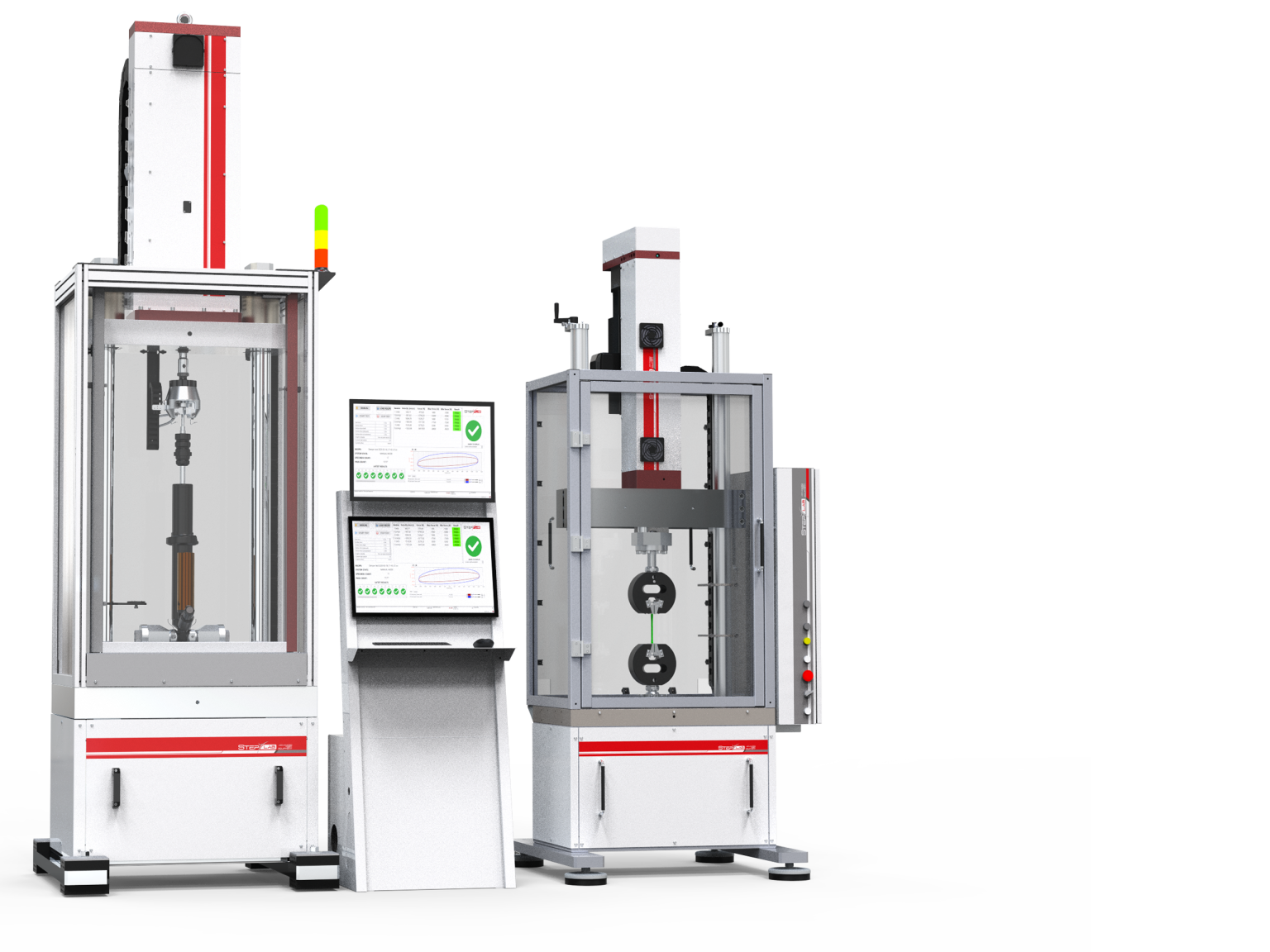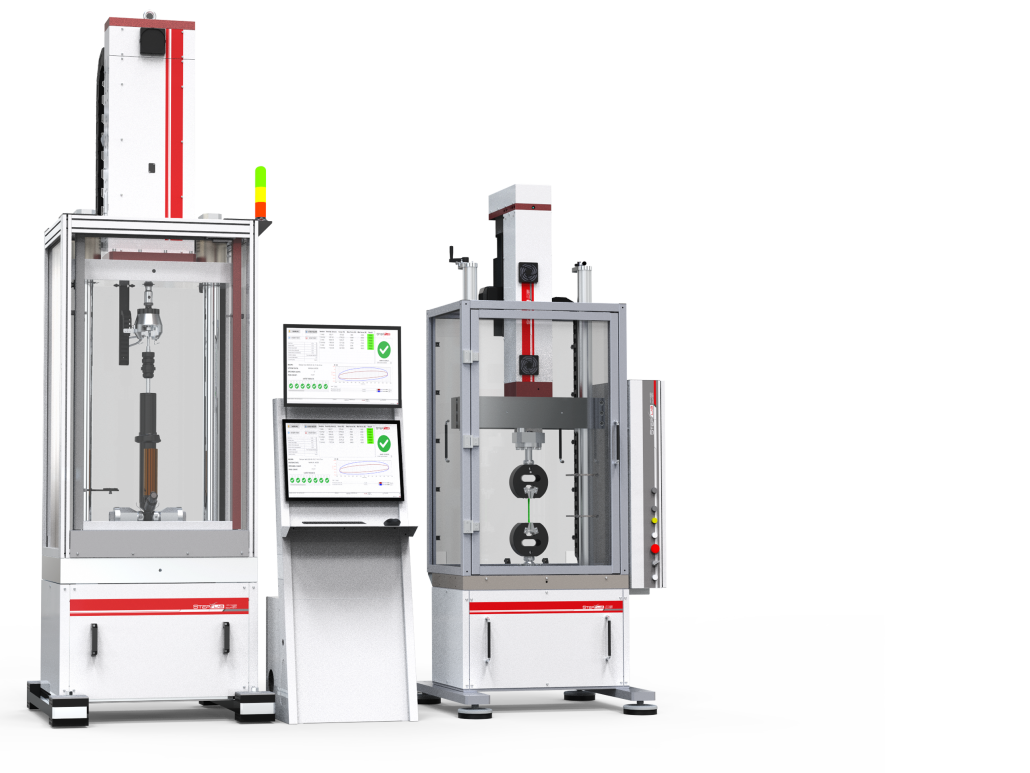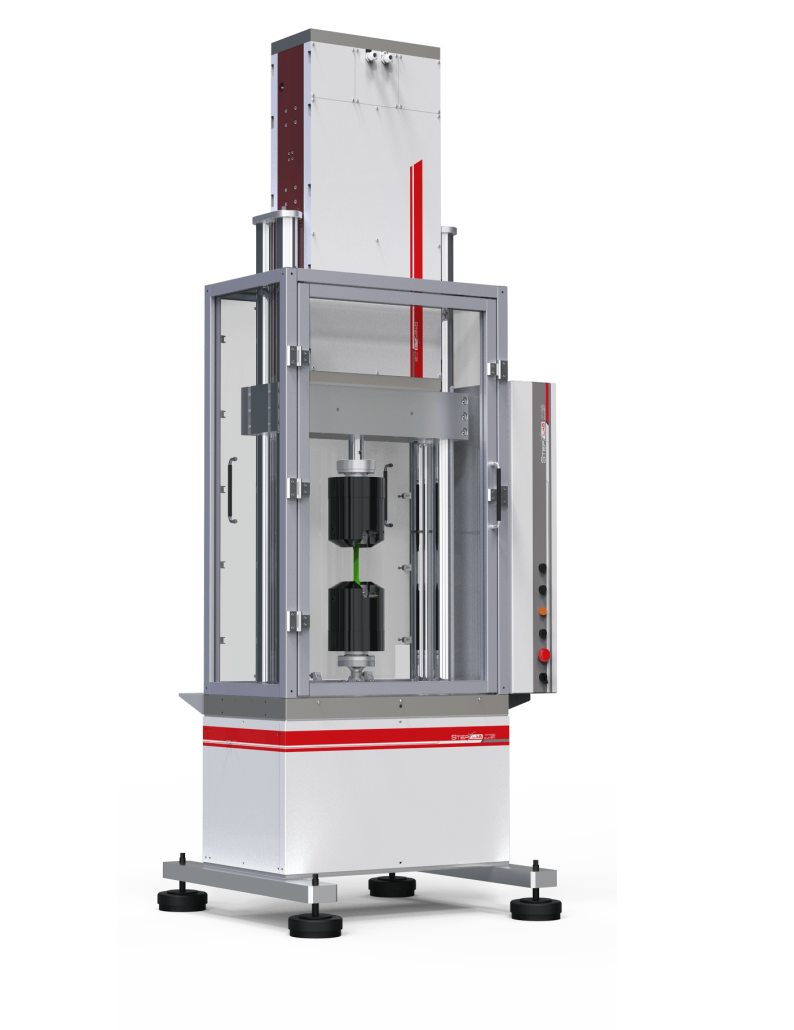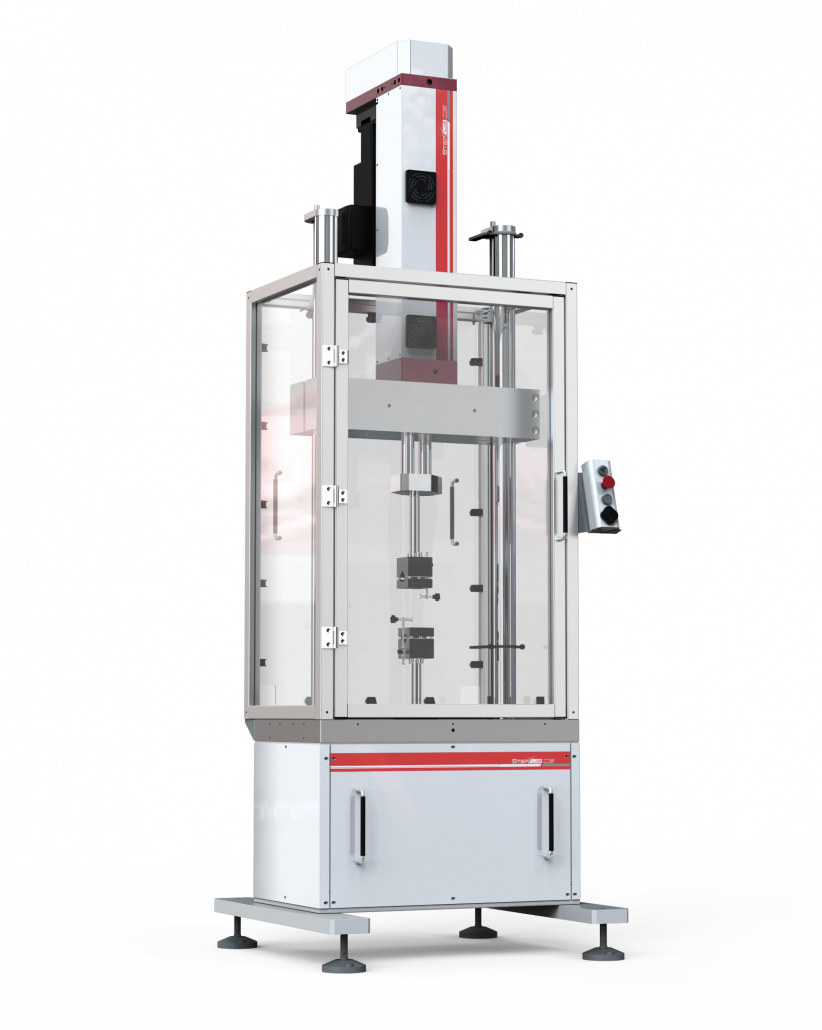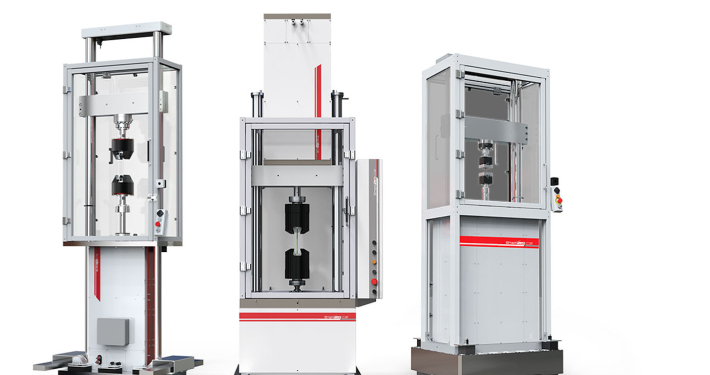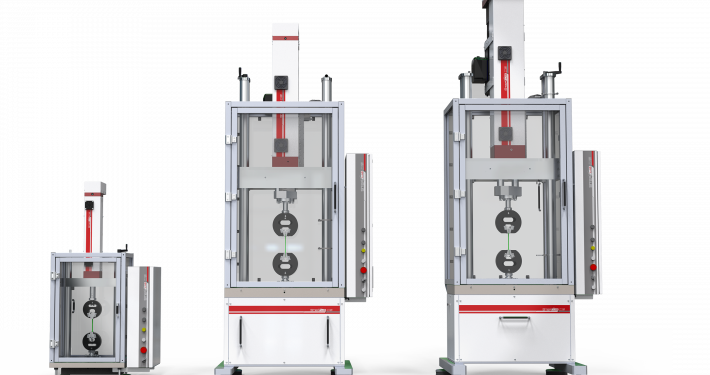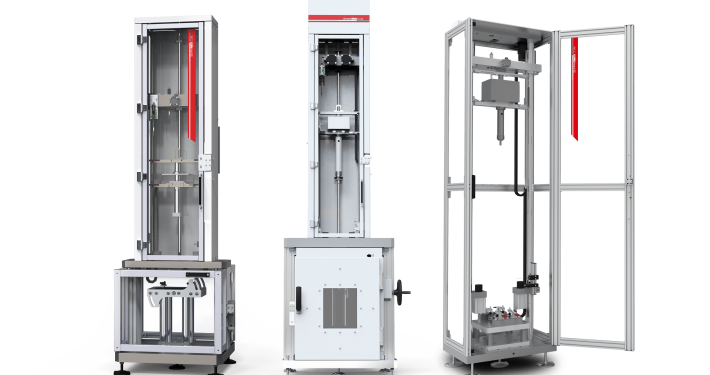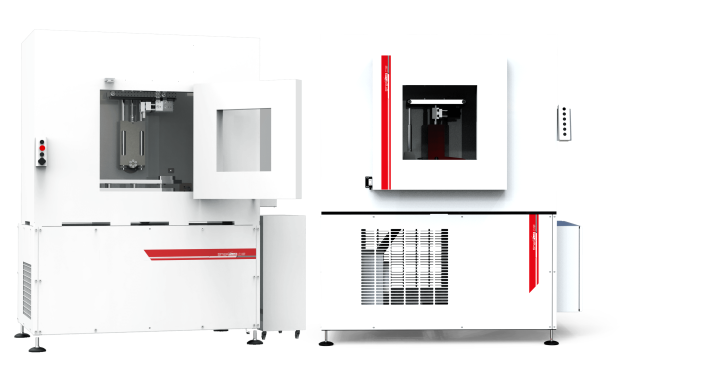TEST SYSTEMS FOR FATIGUE AND DYNAMIC APPLICATIONS
At STEP Lab, we design and produce fatigue test systems and dynamic testing machines designed to meet the most demanding material and product testing needs. From tensile and compression tests to bending, peel, shear, and friction evaluations, our systems deliver precision and reliability. Fully compliant with ASTM, ISO, and other standards, our solutions offer high performance across a variety of industries, from automotive to aerospace.
DYNAMIC AND FATIGUE TESTING MACHINES
Our dynamic testing machines are based on both linear motors and electromechanical actuators, offering unmatched performance. With capacities reaching up to 200 kN, our fatigue test systems cover various applications and meets the most stringent requirements of ASTM, ISO and other standards.
UD SERIES
LINEAR MOTOR-BASED SYSTEMS
Our electrodynamic actuators based on linear motors reach accelerations of tens of g, frequencies of 500 Hz and continuous loads of 100 kN with peaks up to 120 kN.
EA SERIES
ELECTROMECHANICAL SYSTEMS
The electromechanical actuators are suitable for tests with accelerations of up to 2g with dynamic loads of up to 200kN and are versatile for multi-actuator applications.
EXECUTABLE MECHANICAL TESTS
- High and low cycle fatigue tests
- Thermomechanical fatigue tests
- Crack propagation and growth studies
- Fracture strength tests
- Bi-axial tests
- Axial-torsional, multi-axial tests
- High strain rate tests
- Quasi-static tests
- Creep tests
FEATURES
Standards
BIOMEDICAL
| PROOF | MATERIAL | NORMA | DESCRIPTION |
| Static / Fatigue | Biomedical | ASTM F1264 | Standard Specifications and Test Methods for Intramedullary Fixation Devices |
| Static / Fatigue | Biomedical | ASTM F1717 | Standard test methods for spinal implant structures in a vertebrectomy model |
| Static / Fatigue | Biomedical | ASTM F1798 | Standard test method for the evaluation of static and fatigue properties of interconnection mechanisms and subassemblies used in spinal arthrodesis implants |
| Static / Fatigue | Biomedical | ASTM F1800 | Standard Practice for Cyclic Fatigue Testing of Metal Components of the Tibial Plateau of Total Knee Joint Prostheses |
| Static / Fatigue | Biomedical | ASTM F2068 | Standard specifications for femoral prostheses – metal implants |
| Static / Fatigue | Biomedical | ASTM F2077 | Test methods for intervertebral body fusion devices |
| Static / Fatigue | Biomedical | ASTM F2193 | Standard specifications and test methods for components used in surgical fixation of the spinal skeletal system |
| Static / Fatigue | Biomedical | ASTM F2502 | Standard specifications and test methods for resorbable plates and screws for internal fixation implants |
| Static / Fatigue | Biomedical | ASTM F2580 | Standard practice for evaluating the modular connection of a proximally fixed femoral hip prosthesis |
| Static / Fatigue | Biomedical | ASTM F2706 | Standard test methods for occipito-cervical and occipito-cervical-thoracic spinal implant constructions in a vertebrectomy model |
| Static / Fatigue | Biomedical | ASTM F382 | Standard Specifications and Test Method for Metal Bone Plates |
| Static / Fatigue | Biomedical | ASTM F384 | Standard specifications and test methods for angled metal devices for orthopaedic fracture fixation |
| Static / Fatigue | Biomedical | ASTM F543 | Standard Specifications and Test Methods for Metal Medical Bone Screws |
| Static / Fatigue | Biomedical | EN 843-1 | Mechanical properties of monolithic ceramics at room temperature – Determination of flexural strength |
| Static / Fatigue | Biomedical | ISO 11405 | Tooth structure adhesion test |
| Static / Fatigue | Biomedical | ISO 12189-8 | Mechanical testing of implantable spinal devices – Fatigue test method for spinal implant assemblies using anterior support |
| Static / Fatigue | Biomedical | ISO 14801 | Dentistry – Implants – Dynamic load test for endosseous dental implants |
| Static / Fatigue | Biomedical | ISO 14879-1 | Total knee joint replacement Determining the strength properties of tibial knee trays |
| Static / Fatigue | Biomedical | ISO 6872 | Dentistry – Ceramic materials |
| Static / Fatigue | Biomedical | ISO 7206 | Surgical implants – Partial and total hip joint replacements |
| Static / Fatigue | Biomedical | ISO 9585 | Surgical implants – Determination of flexural strength and stiffness of bone plates |
BICYCLES
| PROOF | MATERIAL | NORMA | DESCRIPTION |
| Static / Fatigue | Bikes | EN 15194 | Electrically assisted pedal cycles – EPAC Bicycles – test methods |
| Static / Fatigue | Bikes | ISO 4210-3 | Bicycle safety requirements – Part 3: Common test methods |
| Static / Fatigue | Bikes | ISO 4210-4 | Safety requirements for bicycles – Part 4: Braking test methods |
| Static / Fatigue | Bikes | ISO 4210-5 | Bicycle safety requirements – Part 5: Steering test methods |
| Static / Fatigue | Bikes | ISO 4210-6 | Safety requirements for bicycles – Part 6: Test methods for frame and fork |
| Static / Fatigue | Bikes | ISO 4210-7 | Bicycle safety requirements – Part 7: Test methods for wheels and rims |
| Static / Fatigue | Bikes | ISO 4210-8 | Safety requirements for bicycles – Part 8: Pedal and drive system test methods |
| Static / Fatigue | Bikes | ISO 4210-9 | Bicycle safety requirements – Part 9: Test methods for saddles and seatposts |
| PROOF | MATERIAL | NORMA | DESCRIPTION |
| Impact | Bikes | JIS D 9431 | Impact test on bicycle saddle |
| Various | Bikes | UCI | Bicycle validation test |
METALS
| PROOF | MATERIAL | NORMA | DESCRIPTION |
| Fatigue tests | Metal | ASTM A370 | Test methods and definitions for the mechanical testing of steel products |
| Fatigue tests | Metal | ASTM E3 | Guide to the Preparation of Metallographic Samples |
| Fatigue tests | Metal | ASTM E4 | Practices for testing machine strength |
| Fatigue tests | Metal | ASTM E8/E8M | Test methods for tensile testing of metallic materials |
| Fatigue tests | Metal | ASTM E9 | Test methods for compression of metallic materials at room temperature |
| Fatigue tests | Metal | ASTM E83 | Practice for the verification and classification of strain gauge systems |
| Fatigue tests | Metal | ASTM E111 | Test method for Young’s modulus, tangential modulus and chord modulus |
| Fatigue tests | Metal | ASTM E112 | Test methods for determining average grain size |
| Fatigue tests | Metal | ASTM E132 | Test method for Poisson’s ratio at room temperature |
| Fatigue tests | Metal | ASTM E177 | Practice for the use of the terms precision and polarisation in ASTM test methods |
| Fracture mechanics | Metal | ASTM E1457 | Measuring creep crack growth times in metals |
| Fracture mechanics | Metal | ASTM E647 | Measuring the growth rate of fatigue cracks |
| Fracture mechanics | Metal | ISO 11782-2 | Corrosion of metals and alloys-corrosion fatigue test: crack propagation test using pre-cracked specimens |
| Fracture mechanics | Metal | ISO 12108 | Metallic materials – Fatigue testing – Fatigue crack growth method |
| Fracture mechanics | Metal | ASTM E647 | Standard test method for measuring fatigue crack growth rate |
| Fracture mechanics | Metal | ISO 7539-6 | Corrosion of metals and alloys – Stress corrosion tests |
| Fracture mechanics | Metal | ASTM E399 | Standard test method for linear-elastic plane-tensile fracture toughness of metallic materials |
| Fracture mechanics | Metal | ASTM E1820-11 | Standard test method for measuring fracture toughness (metals) |
| Creep | Metal | ASTM E139 | Conducting creep, creep-breakage and stress-breakage tests of metallic materials |
| Creep | Metal | ISO 204 | Uniaxial live creep test |
| LCF | Metal | ASTM E606 | Strain-controlled fatigue tests |
| Impact | Metal | ASTM E208 SEP 1325 |
Performing the weight drop test to determine the non-ductility transition temperature of ferritic steels (Pellini’s Test) |
| Impact | Metal | ASTM E23 | Impact tests on notched bar of metallic materials |
| Impact | Metal | ASTM E436 | Drop Tear Tests of Ferritic Steels |
| Impact | Metal | ISO 10274 | Tear test with drop weight |
| Impact | Metal | ISO 148-1 ISO 148-2 |
Charpy impact test |
| Static tests | Metal | ASTM E21 | High-temperature tensile testing of metallic materials |
| Static tests | Metal | ASTM E290 | Material bending test for ductility |
| Static tests | Metal | ASTM E517 | Plastic deformation ratio r for sheet metal |
| Static tests | Metal | ASTM E646 | Tensile hardening exponents (n-values) of sheet metal materials |
| Static tests | Metal | ASTM E8M | Tensile testing of metallic materials |
| Static tests | Metal | ASTM E9 | Compression testing of metallic materials at room temperature |
| Static tests | Metal | EN 10002-1:2001 (replaced by ISO EN 6892-1:2019) | Tensile testing of metallic materials. Test method at room temperature |
| Static tests | Metal | ISO 6892-1 | Metallic materials – Tensile testing Part 1: Test method at room temperature |
| Static tests | Metal | ISO 7438 | Metallic materials. Bending test. |
| Static tests | Metal | ISO 783 | Metallic materials – Tensile test of steel at high temperature |
| Biaxial planar | Metal | ISO 16842 | Biaxial tensile test method with a cruciform specimen |
| LCF | Metal | ASTM E606 | Strain-controlled fatigue tests |
PLASTIC
| PROOF | MATERIAL | NORMA | DESCRIPTION |
| Impact | Plastic | ASTM D1709 | Impact resistance of plastic films with the free-fall dart method |
| Impact | Plastic | ASTM D3763 | High-speed drilling properties of plastics using load and displacement sensors |
| Impact | Plastic | ASTM D5420 | Impact resistance of a flat rigid plastic specimen by a point impacted by a falling weight (Gardner impact) |
| Impact | Plastic | ISO 13802 | Charpy, Izod and tensile tests |
| Impact | Plastic | ISO 148 | Charpy impact test |
| Impact | Plastic | ISO 179-1 ISO 179-2 |
Determination of Charpy impact properties |
| Impact | Plastic | ISO 6603-1 ISO 6603-2 |
Determining the perforation impact behaviour of rigid plastics |
| Impact | Plastic | ISO 7765-1 ISO 7765-2 BS 2782-3 |
Plastic films and foils – Determination of impact strength using the free-fall dart method |
| PROOF | MATERIAL | NORMA | DESCRIPTION |
| Static tests | Plastic | ASTM D638 | Tensile properties of plastics |
| Static tests | Plastic | ISO 527-1 ISO 527-2 |
Plastics-Determination of Tensile Properties |
| High strain rate | Plastic | ISO 8256 | Determination of tensile-impact strength |
| High strain rate | Plastic | SAE J2749 | High-speed tensile testing of polymers |
COMPOSITES
| PROOF | MATERIAL | NORMA | DESCRIPTION |
| Impact | Composites | EN 6038 | Determination of compressive strength after impact (CAI test) |
| Impact | Composites | ISO 18352 | Determination of compressive properties after impact at a specific impact energy level (CAI test) |
| Impact | Composites | ASTM D7136/D7136M | Measuring the damage resistance of a fibre-reinforced polymer matrix composite to a drop-weight impact event (Compression After Impact – CAI) |
RUBBER
| PROOF | MATERIAL | NORMA | DESCRIPTION |
| Static tests | Rubber | ISO 2439 | Determination of hardness (indentation technique) |
| Static tests | Rubber | ISO 3386 | Determination of stress-strain characteristics in compression |
| PROOF | MATERIAL | NORMA | DESCRIPTION |
| Fatigue tests | Rubber | ISO 3385 | Fatigue determination by hammering under constant load |
| PROOF | MATERIAL | NORMA | DESCRIPTION |
| Rubber testing | Rubber | ASTM D3574 | Flexible cellular materials: bonded and moulded urethane foams |

